
The Role of Architects in Combating Climate Change
June 6, 2023Climate change is a pressing issue that we all face, casting its evident impact across every sector of the industry. As global warming worsens, architects now have the opportunity to establish new benchmarks in environmental improvement.
In this article, we’ll explore the role of architects in combating climate change, their impact on the environment, and their responsibility to the planet. We will also showcase the top-winning projects of the Architecture MasterPrize Awards, which set a new standard for meaningful progress in both the industry and our global environment.
How do architects help with climate change?
Architects can help combat climate change in many ways. One of the most significant ways is by designing buildings that are energy-efficient, which reduces carbon emissions and saves energy costs. This can be achieved through the use of sustainable materials, such as recycled materials and those with low embodied energy. But, also through the implementation of energy-efficient technologies, such as solar panels and geothermal heating and cooling systems.
Climate-responsive design is also crucial in combating climate change. Architects must consider the local climate and design buildings that are appropriate for that specific environment. For example, buildings in hot and arid climates can utilize passive design strategies, such as shading and ventilation, to reduce the need for air conditioning. Similarly, buildings in colder climates can use passive solar design to maximize solar gain and minimize heat loss.
Net-zero buildings are another way in which architects can help combat climate change. These buildings produce as much energy as they consume, resulting in zero carbon emissions. Achieving net-zero requires careful planning and design, as well as the use of energy-efficient technologies and renewable energy sources.
How do architects impact the environment?
Architects have a significant impact on the environment, and it is essential that they consider the ecological footprint of their designs. The materials used in construction, transportation, and waste disposal all have an impact on the environment. By using sustainable materials, architects can reduce the carbon emissions associated with construction, as well as minimize waste and promote the circular economy.
Transportation is another significant contributor to carbon emissions. Architects can help reduce the environmental impact of transportation by designing buildings that are easily accessible by public transportation or by encouraging the use of bikes and walking. Architects can also design buildings that have a smaller footprint, reducing the amount of land that needs to be developed.
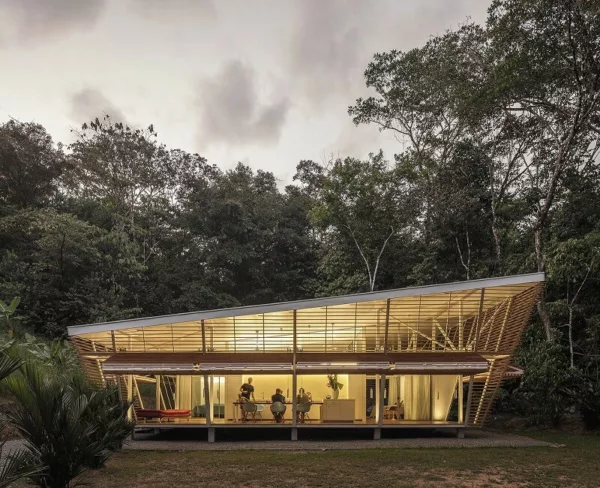
No footprint house
Does an architect have a responsibility to our natural environment?
Architects have a significant responsibility to our natural environment. As stewards of the built environment, architects have the power to create sustainable, healthy, and livable spaces that promote the well-being of people and the planet.
In addition to their responsibility to the environment, architects also have a responsibility to society, ensuring that their designs are equitable, accessible, and inclusive.
What is the role of the architect in sustainability?
The role of the architect in sustainability is to design buildings that are environmentally responsible, economically viable, and socially equitable. This requires a deep understanding of sustainable design principles, as well as an understanding of the local climate, culture, and context.
Architects must work closely with engineers, contractors, and other professionals to ensure that sustainable design strategies are integrated into every aspect of a project.
Biophilic design is an emerging trend in sustainable architecture that seeks to connect people with nature by incorporating natural elements, such as plants and natural light, into the built environment.
This not only promotes the well-being of people but also helps to restore the natural balance of the ecosystem.
Green buildings are a critical component of sustainable architecture as they are designed to minimize their environmental impact, reduce energy consumption, and promote the use of renewable energy.
By using sustainable design principles, such as climate-responsive design, passive design, and the use of sustainable materials, architects can create buildings that are energy-efficient and have a lower ecological footprint. However, sustainable design is not a one-time effort, but rather a process of continuous improvement.
As technologies and practices continue to evolve, architects must remain up-to-date with the latest developments in sustainable design and incorporate them into their projects.
Top winning projects of Architecture MasterPrize in using natural materials in construction and demonstrating profound respect for the environment of our planet:
1. The Arc at Green School Bali
Designed by IBUKU, is a prime example of a green building, using all natural materials in construction. Located in Bali, Indonesia, the building represents the excellence of engineering in using a series of bamboo arches in modern architecture. The building serves as the new gymnasium of the world famous alternative school; Green School in Bali.
The project is a testament to the role of architects in combating climate change and setting up new standards in our built environment.

The Arc at Green School Bali (Architectural Design of the Year – AMP – 2021)
2. Sara Cultural Center
A timber skyscraper that serves as a venue for arts, performances, and literature, devoted to the service of the public.
As an environmentally friendly high-rise structure and one of the tallest timber buildings in the world, it was constructed using a wide range of innovative solutions in mass timber construction.
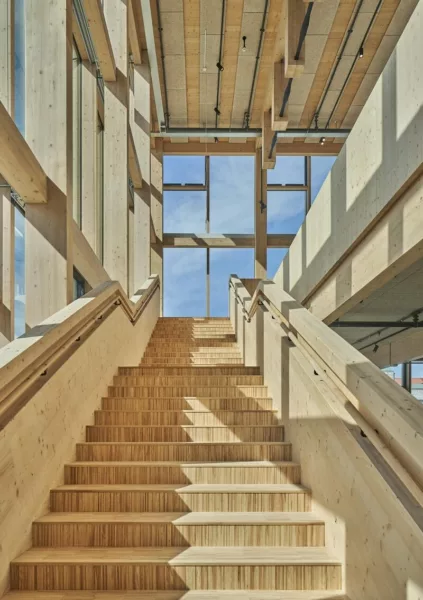
Sara Cultural Center (Best of Best in Cultural Architecture – AMP – 2022)
3. The Dock Building
Located in Vancouver, Canada, designed by MGA | Michael Green Architecture, a world leading architectural firm specialized in timber buildings and large-scale sustainable construction, serves as a spacious marina for sailboats.
The project is designed to fulfill practical working requirements and stands as an exceptional example of both practicality and architectural beauty.
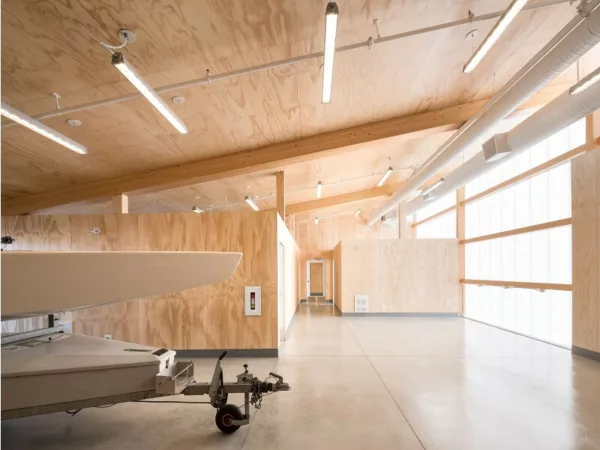
The Dock Building (Best of Best in Commercial Architecture – AMP – 2020)
4. No Footprint House (NFH)
In combating climate change, A-01 has developed a prototype residential house that aims to minimize the negative impact of construction on the environment.
The house not only seeks to utilize sustainable natural materials but also integrates sustainability into its economic, social, and spatial performance.
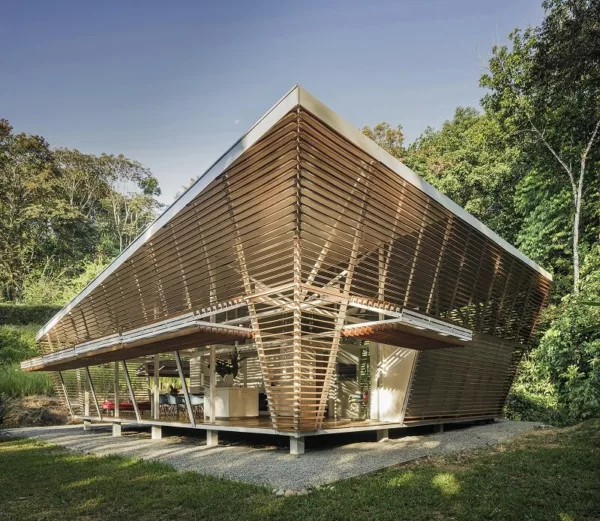
No Footprint House (NFH) – (Best of Best in Green Architecture – AMP – 2020)
5. Nocenco Cafe
is a renovation project located in Vietnam, designed by VTN Architects (Vo Trong Nghia Architects). Pioneering in the use of bamboo in modern architecture, VTN Architects has designed the building using locally sourced materials.
Recognizing the unique characteristic of bamboo and its lightweight nature, the construction was carried out with fewer labor and tailored to suit the tropical climate, utilizing readily available bamboo materials.

Nocenco Cafe (Interior Design of the Year – AMP – 2020)
6. The Ford Calumet Environmental Center
Center was designed by Valerio Dewalt Train. The building serves to educate visitors about the region’s past and set a precedent for a sustainable future where industry, nature, and culture can coexist.
The facility features a permanent exhibit, classrooms, offices, a bike repair area, restrooms, and storage spaces. The building incorporates sustainable design strategies such as rainwater harvesting and uses natural light to reduce energy consumption.
The project is a testament to the role of architects in combating climate change and promoting sustainability in our built environment.

Ford Calumet Environmental Center (WINNER in Green Architecture – AMP 2022)
7. The Glorieta Cibeles Tower
is a complete up-cycle of a structure abandoned after the historic 1985 earthquake. Designed as a sculptural inhabitable obelisk, the transformation comprised four fundamental axes: structure and resilience; comfort and functionality; aesthetic and tectonic design; and sustainability, in operational and embodied energy.
The intervention demonstrated that old deteriorated structures can be revitalized while exceeding all the current requirements of comfort, efficiency, sustainability, resiliency, and flexibility, becoming an example of urban recovery and renewal.
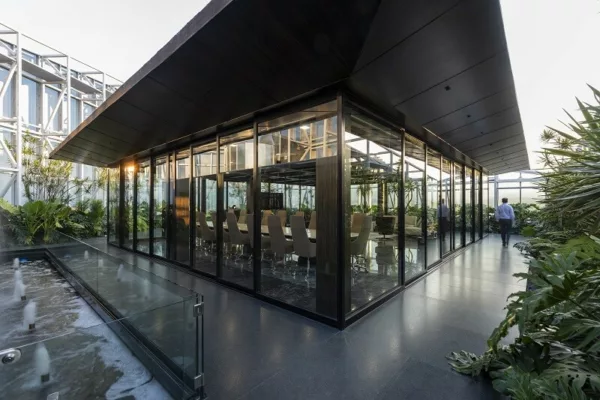
Glorieta Cibeles Tower (WINNER in Green Architecture – AMP 2022)
Architects and Climate Change
Architects play a critical role in combating climate change by designing energy-efficient, sustainable buildings that reduce carbon emissions and promote the use of renewable energy sources. Sustainable design principles, such as climate-responsive design, passive design, and the use of sustainable materials, are essential in achieving this goal.
As stewards of the built environment, architects have a significant responsibility to our natural world, and it is essential that they embrace this responsibility and work towards a more sustainable future.
The winning projects of Architecture MasterPrize in Green Architecture serve as excellent examples of sustainable design in action and provide inspiration for architects looking to create a more sustainable built environment.

